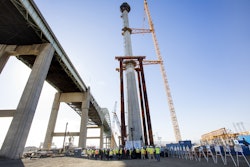 Photo: RAND Corporation
Photo: RAND CorporationU.S. infrastructure definitely needs attention but political alarms about crumbling demise are overblown, according to a new study by the RAND Corporation, a nonprofit policy research organization.
Concerns about transportation and other infrastructure – roads, bridges, airports, water systems – have led some politicians to call for large spending increases, but the RAND study says “much of the nation’s transportation and water infrastructure is adequately maintained.” Instead, it says, an annual increase of 2.5 to 3 percent above the $235 billion spent by all local, state and federal governments combined “would eliminate existing maintenance backlogs by 2030.”
The study doesn’t mention President Trump’s $1 trillion proposal to improve the nation’s infrastructure, but is skeptical of large-scale funding increases to try to solve the problem. Instead, it recommends a more targeted approach.
“An across-the-board ramp-up of federal spending is unlikely to solve the infrastructure problems that need fixing,” the report says. “Lasting changes will require thoughtful consideration of targeted spending priorities, policy constraints and regional differences.”
It also recommends increasing public-private partnerships for funding projects, which currently represent only 1 percent of total funding. Trump earlier this year backed off a previous proposal to fund his $1 trillion proposal by public-private partnerships and has been leaning more toward a fuel tax increase.
The study notes that state and local governments bear the brunt of infrastructure funding, and the federal government should lend greater support to them. It also criticizes the current approach of “spreading federal dollars around to fund short-term, ‘shovel-ready’ projects without a sense of national purpose or priority.”
The study found that, on the whole, there is no evidence of a “precipitous decline in national spending on the physical condition of transportation and water infrastructure.”
The study, however, does recognize that the federal Highway Trust Fund and many states’ water and sewer funds have been unsustainable, and that many communities with dwindling tax bases are struggling to maintain infrastructure.
The study recommends some steps Congress should take:
- Focus on maintaining and modernizing vital federal infrastructure.
- Target nationally significant projects that are beyond the capacity of individual states and cities. Those include regional highway and rail line connections, airport modernization, major dam repairs, and infrastructure on military installations, in national parks and other publicly managed recreational areas, says Debra Knopman, lead author of the report.
- Preserve the federal tax exemption on municipal bond interest.
- Reinstate Build America Bonds, which are taxable municipal bonds that come with tax credits or federal subsidies for bondholders and issuers.
- Experiment with financing alternatives to keep capital flowing to local and state infrastructure investment, including public-private partnerships.
- Use advanced technologies to support newer construction methods, more-durable and sustainable materials and sensor technologies that might benefit infrastructure maintenance.
- Require projects to withstand natural disasters and climate change to reduce future spending on disaster assistance.
The report, “Not Everything Is Broken: The Future of U.S. Transportation and Water Infrastructure Funding and Finance,” is available at rand.org.












